The blue town of Bundi feels like a touch of old India. It is off the tourist trail and, as yet, uncorrupted by the hordes of visitors that we have encountered elsewhere. It’s a captivating place with narrow twisty lanes, grand old town gates, little shops and bazaars; a place where we can wander without continual harassment. There are no stand-alone restaurants in this sleepy backwater; a measure of how innocent it remains.
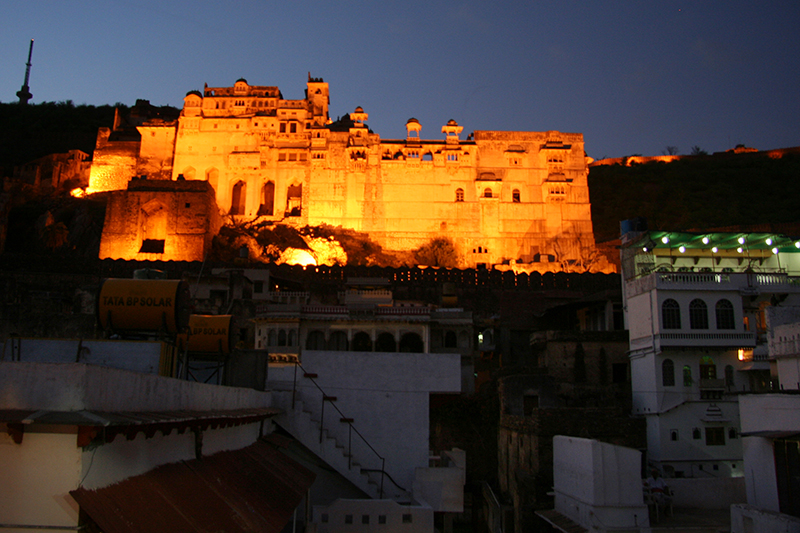 Set in a valley, surrounded by green hills, it is dominated by a crumbling royal palace that appears to be carved out of rock, sitting on the flat rooftops of the town’s houses. Above the palace, on top of the highest hill, sits a fort guarded by a series of thick ramparts which was the stronghold of the Hadoti Chauhans who conquered the area in the 12th Century.
Set in a valley, surrounded by green hills, it is dominated by a crumbling royal palace that appears to be carved out of rock, sitting on the flat rooftops of the town’s houses. Above the palace, on top of the highest hill, sits a fort guarded by a series of thick ramparts which was the stronghold of the Hadoti Chauhans who conquered the area in the 12th Century.
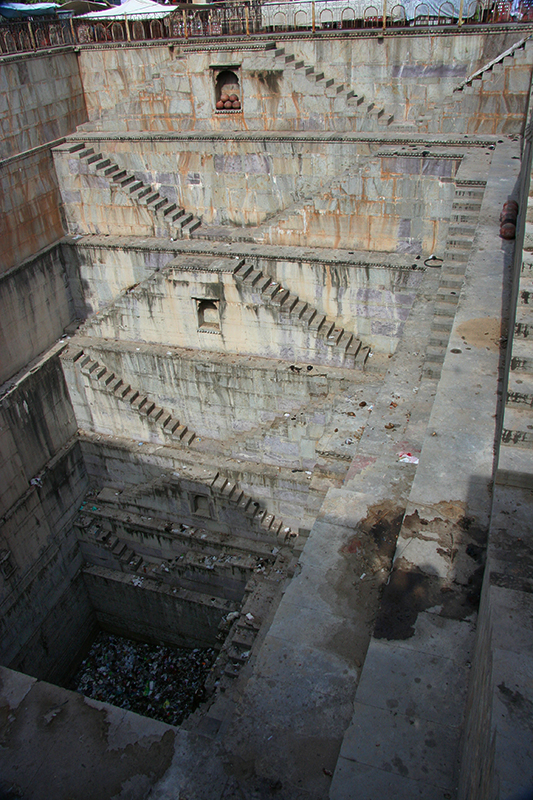 The town also has many baoris (step wells) dug into the ground to a depth of up to 50 metres in which town’s folk would walk down a series of steps to fetch water and wash. Some of them, like the Ranji-ki-Baori (Queen’s Step Well) are decorated with wonderful carvings of deities. But all of them are disused, unloved and full of rubbish. Another example of India’s rich heritage that has been allowed to decay. It is perplexing that a country that earns 7 billion Rupees (US$1.5 billion) from tourism and which charges hefty entry fees to all its heritage sites, can allow them to rot away. Why can’t they see that it is in their own interests to look after them and be proud of them?
The town also has many baoris (step wells) dug into the ground to a depth of up to 50 metres in which town’s folk would walk down a series of steps to fetch water and wash. Some of them, like the Ranji-ki-Baori (Queen’s Step Well) are decorated with wonderful carvings of deities. But all of them are disused, unloved and full of rubbish. Another example of India’s rich heritage that has been allowed to decay. It is perplexing that a country that earns 7 billion Rupees (US$1.5 billion) from tourism and which charges hefty entry fees to all its heritage sites, can allow them to rot away. Why can’t they see that it is in their own interests to look after them and be proud of them?
The palace is another case in point. For the past 5 years they have been charging visitors an entry fee as well as a camera fee, ostensibly to enable preservation and renovation, but there is no evidence of any money having been spent on either. The only benefit has been that it has stopped the locals from entering the grand building to scrape the gold paint off the murals and help themselves to anything else that took their fancy. Nowadays only a small portion of this once enormous palace is safe enough for visitors but we still have to arm ourselves with sticks to fend off the resident monkeys and avoid the excrement and urine these animals leave everywhere.
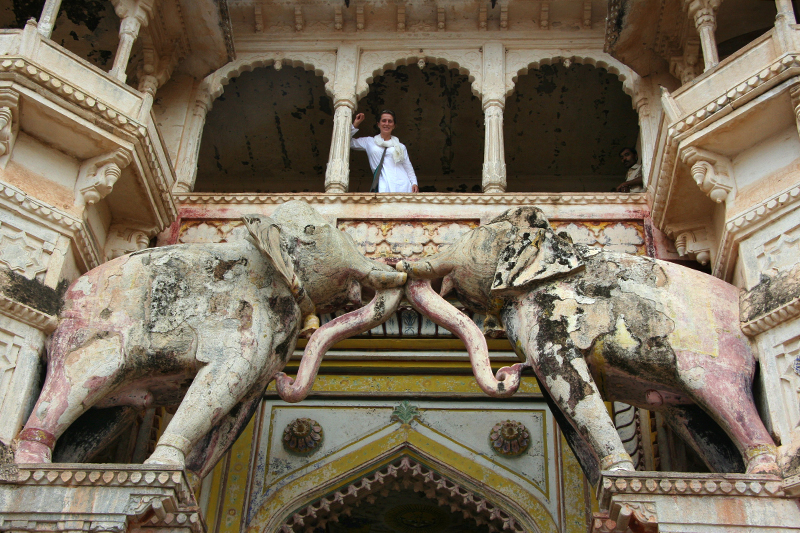 That said, it must have been a magnificent place in its heyday (1607). A cobbled, twisting road leads up to a grand entrance guarded by huge carved elephants and grave, dark doors studded with spikes. Once inside, a garden welcomes, surrounded by a gallery where the ruler met with his people. The rooms have many interesting murals and intricately decorated ceilings often involving Krishna or victorious battles. The private quarters used ornately carved marble inlaid with stone and mirrors in a rabbit warren layout that requires a compass to navigate. The views over the town, out across to the surrounding hills and flat plains are wonderful. The washed out light blue of the town, contrasts with the bold, rich green of the hills and the flat plain in between eventually vanishes as it merges with the sky. From the vantage point of his palace, the Maratha could view much of his domain.
That said, it must have been a magnificent place in its heyday (1607). A cobbled, twisting road leads up to a grand entrance guarded by huge carved elephants and grave, dark doors studded with spikes. Once inside, a garden welcomes, surrounded by a gallery where the ruler met with his people. The rooms have many interesting murals and intricately decorated ceilings often involving Krishna or victorious battles. The private quarters used ornately carved marble inlaid with stone and mirrors in a rabbit warren layout that requires a compass to navigate. The views over the town, out across to the surrounding hills and flat plains are wonderful. The washed out light blue of the town, contrasts with the bold, rich green of the hills and the flat plain in between eventually vanishes as it merges with the sky. From the vantage point of his palace, the Maratha could view much of his domain.
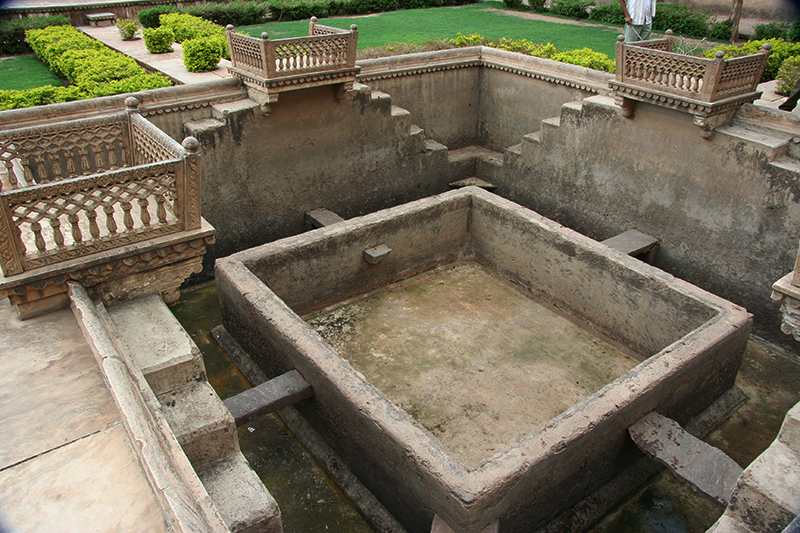 Next door to the main palace is a smaller one, Chitrasala, that was tagged on to the original building in the 18th century. It has a beautiful small garden courtyard with a lovely little step well in the centre. Behind this, and screened by wire caging to keep out the monkeys, is an area used by the women of the palace that has well preserved and has delicately painted murals. The columns holding up the roof are inlaid with mirrors that catch the light and sparkle. It must have seemed like the most opulent home in Rajasthan.
Next door to the main palace is a smaller one, Chitrasala, that was tagged on to the original building in the 18th century. It has a beautiful small garden courtyard with a lovely little step well in the centre. Behind this, and screened by wire caging to keep out the monkeys, is an area used by the women of the palace that has well preserved and has delicately painted murals. The columns holding up the roof are inlaid with mirrors that catch the light and sparkle. It must have seemed like the most opulent home in Rajasthan.
We carried on up the hill to reach the fort, along a switchback path that threads its way through the defensive walls and past the vegetation that has successfully invaded the spaces. At the top, the last bastion stands defiant but dilapidated in an area that is dotted with thick walled, overgrown, defensive positions and deep reservoirs carved out of solid rock. Great wiry trees grow all around dripping with brown hairy creeper. There is a foreboding and slightly menacing alien air to it all. The dark fairytale scene moved Kipling to write, “This is such a place as men built for themselves in uneasy dreams, the work of goblins rather than of men.”
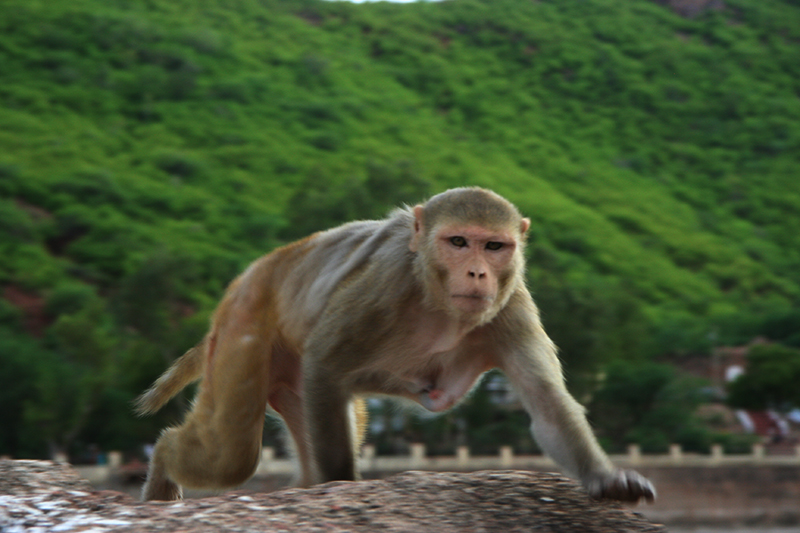 The fort itself is overrun by hordes of monkeys who have claimed the buildings for themselves. They don’t look too pleased to see us. They observe us as intruders and follow us around in a way that is very uncomfortable. We keep our walking sticks constantly at the ready, having to clear the way ahead by banging walls and floors. Decay and sadness fills every nook and cranny of this once impenetrable fortress and it is a shame that it has been allowed to slowly disintegrate. It is only because the construction is so robust that the fort still stands. The monkeys, it seems, are the only beings that care about this place.
The fort itself is overrun by hordes of monkeys who have claimed the buildings for themselves. They don’t look too pleased to see us. They observe us as intruders and follow us around in a way that is very uncomfortable. We keep our walking sticks constantly at the ready, having to clear the way ahead by banging walls and floors. Decay and sadness fills every nook and cranny of this once impenetrable fortress and it is a shame that it has been allowed to slowly disintegrate. It is only because the construction is so robust that the fort still stands. The monkeys, it seems, are the only beings that care about this place.
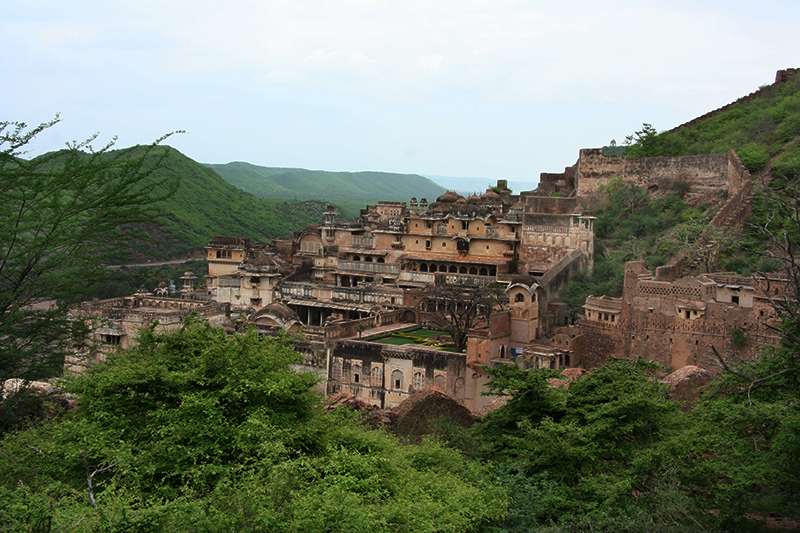 Again, the views are fantastic of the surrounding area. We draped ourselves over the battlements and enjoyed the picturesque landscape of the Chappan Hills where once tigers, deer and boar were hunted, the holy Jait Sagar Lake on whose shores Rudyard Kipling wrote much of Kim, and imagined ourselves the rulers of all we surveyed.
Again, the views are fantastic of the surrounding area. We draped ourselves over the battlements and enjoyed the picturesque landscape of the Chappan Hills where once tigers, deer and boar were hunted, the holy Jait Sagar Lake on whose shores Rudyard Kipling wrote much of Kim, and imagined ourselves the rulers of all we surveyed.
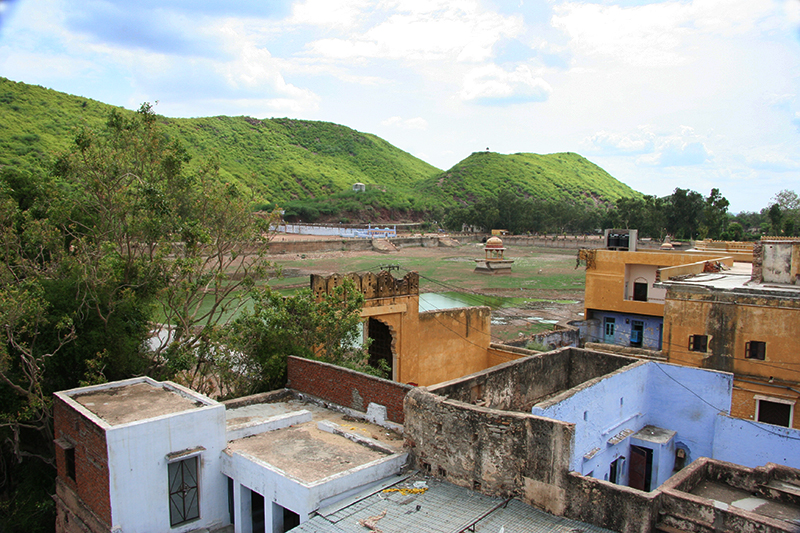 It is surprising that the countryside is as green as it is given that the monsoon rains have not yet arrived. In Bundi, the artificial lake of Nawal Sagar is dry, the hotel where we are staying has to receive water from tankers and the town’s people have to draw water from bore holes 7 metres deep. They have to draw water from pumps anyway, there being no running water, but even these deep wells are estimated to dry up in the next two weeks. No wonder the annual arrival of rain is treated as a cause for celebration. I hope the monsoon comes the day after we leave.
It is surprising that the countryside is as green as it is given that the monsoon rains have not yet arrived. In Bundi, the artificial lake of Nawal Sagar is dry, the hotel where we are staying has to receive water from tankers and the town’s people have to draw water from bore holes 7 metres deep. They have to draw water from pumps anyway, there being no running water, but even these deep wells are estimated to dry up in the next two weeks. No wonder the annual arrival of rain is treated as a cause for celebration. I hope the monsoon comes the day after we leave.
Chatting to the hotel owner, a young chap in his thirties, we learn that nothing gets done in Bundi without baksheesh (a bribe). In order to get sanitation in his establishment, he had to pay the town authorities a negotiated sum of money to install pipe work and waste collection all of which he also had to fund. The authority provided nothing.
He also wanted a bank loan to purchase and renovate a second hotel opposite. None of the commercial banks would consider lending him anything. So he went to the state bank where an official said that he could organise a substantial loan for baksheesh of 50,000 Rupees (around US$1,000). Having paid the sweetener, our owner was granted a loan far in excess of that required. He used the extra cash to become a loan shark; something of which he is immensely proud and which has made him far more money than running hotels.
Not surprisingly, he has a very positive view of the future of India. He felt that hard work and a good karma (fate) were all that was required for anyone to become rich. There were no barriers to success other than keeping under the radar scope of the authorities. He had little time for most other, poorer people whom he considered lazy, workshy and relying on their women to keep them in food and water. Such people, he proclaimed, were at the bottom of society, they were nothing more than human animals whose lives counted for little. I wondered if this was a common view amongst those better off and those in authority, as it may explain why basic services are largely absent in a country whose economy is considered to be a driving force of the new world order.
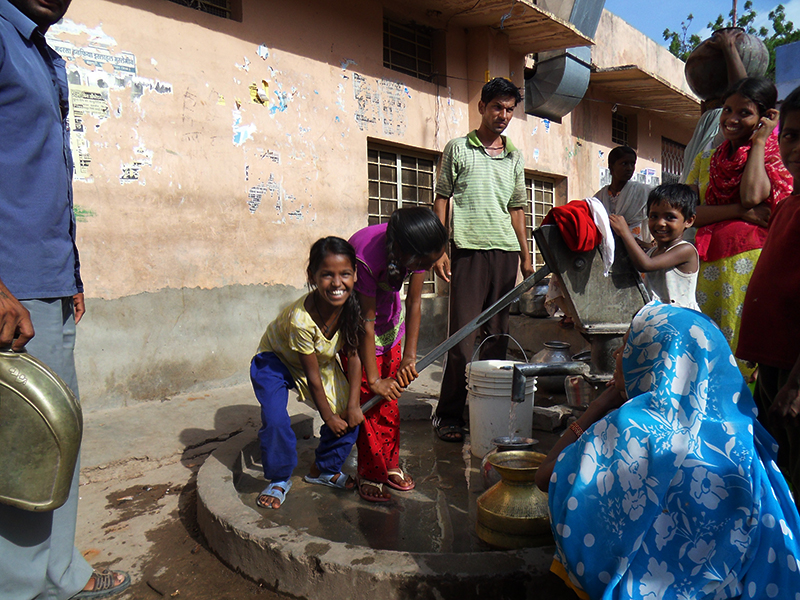 There was a report in the newspaper that said that, according to the latest United Nations statistics, 55% of the Indian population (about 650 million people) was poor. This meant that they are deprived of at least a third of an essential list of requirements such as sanitation, education and basic foods. Not great for a Tiger Economy. Not great either for a nation that has the second highest number of billionaires.
There was a report in the newspaper that said that, according to the latest United Nations statistics, 55% of the Indian population (about 650 million people) was poor. This meant that they are deprived of at least a third of an essential list of requirements such as sanitation, education and basic foods. Not great for a Tiger Economy. Not great either for a nation that has the second highest number of billionaires.
We also chatted about arranged marriages. This subject had come up before in a conversation with someone in Agra who told us that he never saw his wife’s face until after he was married. “And when you did,” Debbie asked, “were you happy?”
“No, I was not,” he replied.
It was perfectly obvious that he disliked his wife very much. He had married her because his parents wished it and he could not divorce her because of the social stigma. Nonetheless, he was already looking for a husband for his daughter. His daughter would accept his choice for her because that was the Indian way. I was sorry that I never asked the obvious question which was “If your experience of an arranged marriage was so bad, why do you want to put your daughter through it?”
Our current hotel owner explained that children were effectively the property of the parents. It is their duty to marry off their children in as advantageous a match as could be engineered. That in itself is fairly complicated, as the marriage is expected to be not only within a caste but also within one of the innumerable branches of the caste.
Daughters went to the husband’s family with a dowry of around 500,000 Rupees (approx US$10,000) in his case. Once in the husband’s family, the daughter would be put to work helping with family chores or whatever was deemed needed to be done. Someone who had 4 daughters would be considered a very unlucky and very poor man, having to work his backside off in order to get his daughters married!
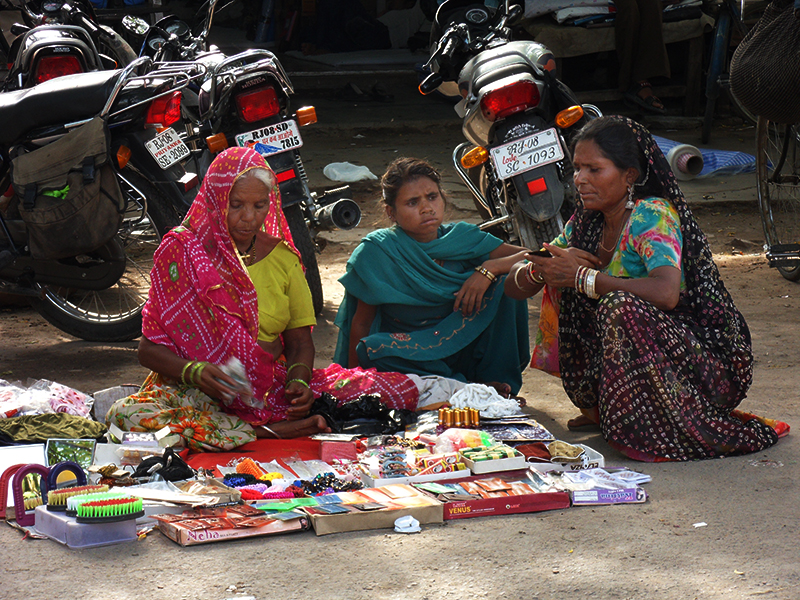 It is an aspect of Indian society that seems alien to us westerners dominated as we are by our women. It is difficult to make judgments about arranged marriages being from such a different culture, but it happens and there seems little complaint. While Indian women are treated so badly, it probably will not change but, I feel that, once women become better educated and have better prospects, things will begin to change slowly.
It is an aspect of Indian society that seems alien to us westerners dominated as we are by our women. It is difficult to make judgments about arranged marriages being from such a different culture, but it happens and there seems little complaint. While Indian women are treated so badly, it probably will not change but, I feel that, once women become better educated and have better prospects, things will begin to change slowly.
The one thing that really disappointed in our conversations was when I asked whether there was significance in the fact that the town was painted blue. ‘No,’ he said, ‘it is Brahmin-blue because that is the cheapest paint.’

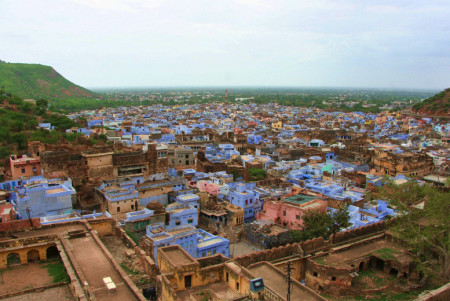
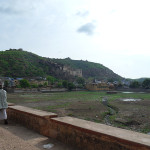
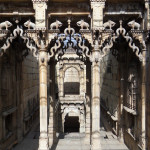
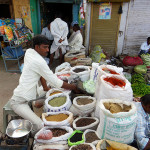
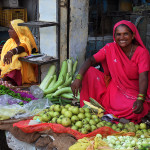

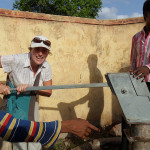

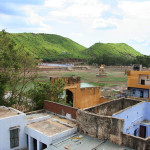

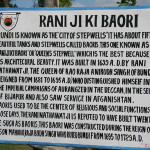
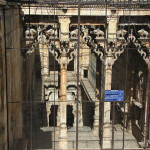
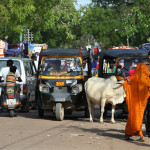
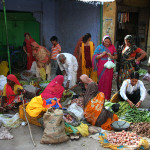
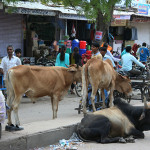
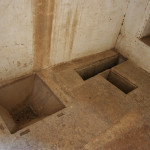
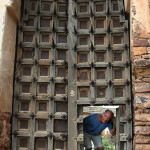
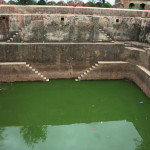
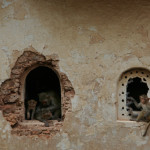
No comments yet.